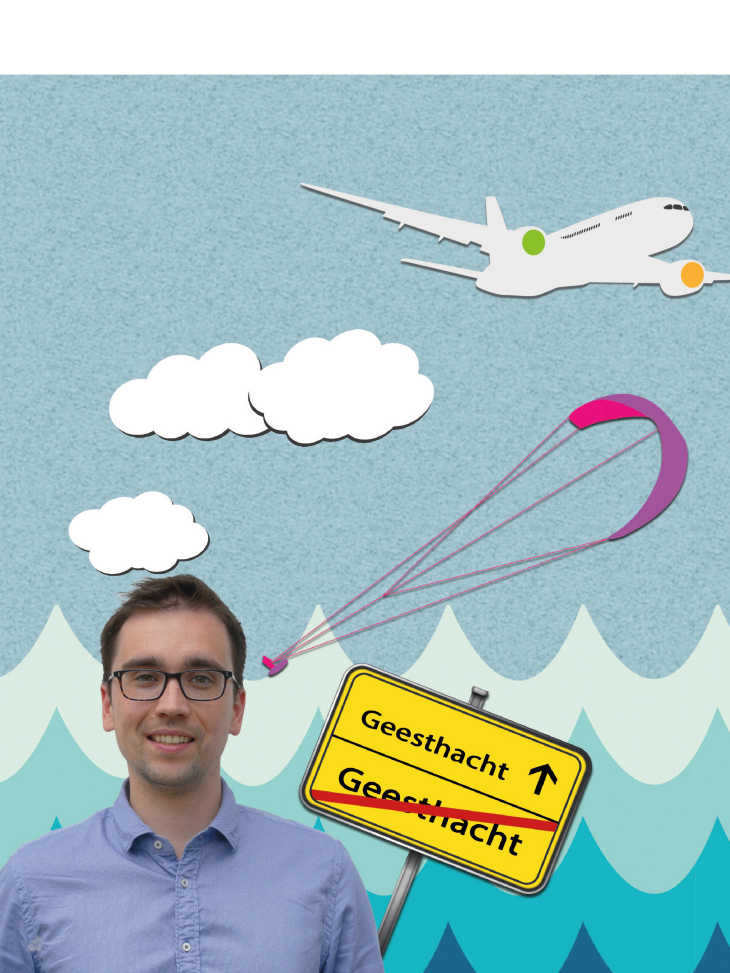Martin Reimann: From School Laboratory Participant to Doctoral Candidate
The mechanical engineer who returned to his hometown of Geesthacht

Photo: Hereon/Gesa Seidel, Graphic: RoseFlohr Kommunikation
Martin Reimann works on new joining processes
It’s a warm and sunny day when Martin Reimann takes time out for a chat. He is surrounded by stacks of paper in his office, which the mechanical engineer shares with a colleague. He quickly suggests we get some fresh air. He carries a table from the experimentation hall, then two chairs, and we eventually find ourselves sitting in the shade behind the building. Then he begins to talk.
The native Geesthachter first came into contact with the Hereon in the school laboratory “Quantensprung”. At the time, he was attending Otto Hahn Gymnasium in Geesthacht. “When I was in my tenth year of school, we made a day trip to what was known as the GKSS at the time, where we connected a fuel cell model to a wind turbine,” says the 29-year-old. He has always had great interest in scientific and technical subjects. “After finishing school, it was immediately clear that I wanted to study mechanical engineering,” he adds.
And that’s just what he did. He completed both his master’s and bachelor’s degrees at the Technical University of Darmstadt. In the meantime, he engaged in student projects and took on internships, which led him to Lufthansa Technik AG in Hamburg and even to London. There, he researched areas such as engine repair and maintenance.
“We investigated changes and properties associated with certain repair procedures. Does a component get lighter after repairs? More efficient? Better? Or does the repair have negative effcts? This is how we can decide if it pays to do a repair or if it’s better if the component is completely replaced,” explains Reimann.
The mechanical engineer liked his internships so he wrote his master‘s thesis at Lufthansa Technik. Here he tested „friction point welding“ in a new application. Different metal sheets are joined together in this technology so that they don’t melt, but remain in a fixed state. A special tool is used that creates frictional heat when rotating on the plates to be joined.
His doctoral work is undertaken within the framework of a technology transfer project – this also involves a collaboration with Lufthansa Technik. At the Hereon, he works at the Institute of Materials Research in the Department of Solid State Joining Processes.
“That all seems like it was planned. It was actually a coincidence that I worked for Lufthansa again and again—and that I returned here to Geesthacht. It was just luck,” Reimann says with a smile.
The doctoral candidate studies different possible applications in relation to borehole sealing. Reimann explains, “I carry out feasibility studies for this. I inspect pieces that have a hole and examine precisely whether and how they can be sealed using friction spot welding.” His doctoral work, overseen by his advisor and Hereon Institute Director Prof Norbert Huber, is affiliated with the TU Hamburg. It lasts three years and will be completed in December 2017.
Are there any initial results? “Absolutely. The procedure can definitely be used for sealing boreholes. Conceivable applications include not only repairs, but also tank production for space shuttles or dishes on satellites.” Everything is going according to plan at the moment.
“The beauty of my studies is that I get to work on concrete goals. It‘s nice to know that my results can be utilised,” Reimann says.
Even though his research brings him a lot of joy, he often heads to a natural environment when he gets off work: on the island of Fehmarn, he lets the wind caress his face and goes kite surfing with his office mate. “We even pack our bags before work and drive directly from the Hereon to the Baltic Sea. With some luck, we’ll have two sunny hours we can enjoy on the water,“ he says. Even in winter he can’t resist the kites. “I went snow kiting in Norway this year – it’s like on water, except you’re pulled by the kite through the snow-covered landscape.”
Author: Gesa Seidel
Portrait from in2science #4 (June 2017)
